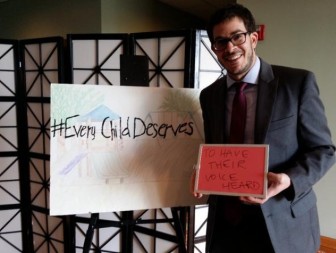 A national association of judges wants to stop the indiscriminate shackling of youth in juvenile court.
A national association of judges wants to stop the indiscriminate shackling of youth in juvenile court.
The National Council of Juvenile and Family Court Judges released a resolution Monday that supports a policy against shackling children, with exceptions made on a case-by-case basis.
“I cannot think of a more fundamental right of due process and basic human dignity than for a child to be able to face a juvenile court judge without shackles unless there is a true safety concern for the child or participants in court,” said Darlene Byrne, the group’s president, in a statement.
The group is the latest to oppose the policy, citing concerns for children’s health and development, as well as their due process rights. The policy statements have rolled in along with a growing momentum to create state laws against the shackling of juveniles.

NJDC
David Shapiro, manager of the Campaign Against Indiscriminate Juvenile Shackling
David Shapiro, manager of the Campaign Against Indiscriminate Juvenile Shackling, housed at the National Juvenile Defender Center, said the group’s position is a huge win.
“We hear from judges that they don’t think they are the ones who are in charge of their own courtrooms, and this makes it clear that they are,” he said.
The support of judges is also important as reformers make their case to limit shackling in the states, Shapiro said.
Twenty-one states have a law, court rule, court opinion or statewide policy that limits the shackling of juveniles in the courtroom at some stage of court proceedings. The other 29 have no written guidance, nor does the federal government.
Shapiro said the resolution and the push for legislation in the states without guidance wouldn’t prevent the use of shackles if a child posed a safety risk.
[Related: Opinion — Indiscriminate Shackling of Children in Juvenile Court Should End]
“All we’re saying is that judges should have the discretion and that it should be the presumption because it is harmful to children,” he said.
Crystal Duarte, program director for coordinated policy and practice at the National Council, said the resolution builds on the group’s guidelines from 2005 that call for a continuum of effective and least intrusive responses in juvenile justice.
As reform efforts have moved across the country, the group wanted to participate.
“There is a lot of attention nationally and we wanted judges to have a voice in that,” she said.
 The resolution also calls on judges to use their leadership positions to convene stakeholders around the issue of shackling and for the regular review of policies related to shackling.
The resolution also calls on judges to use their leadership positions to convene stakeholders around the issue of shackling and for the regular review of policies related to shackling.
Duarte said that in some places, older policies against shackling slowly unraveled without much fanfare, leaving judges and others to think shackling was the way things had always been. Regular reviews should help keep anti-shackling policies in place, she said.
“We don’t want them to be undone,” she said.
The association represents 1,600 members and distributes its policy statements to many more.
Groups including the Child Welfare League of America, the American Bar Association and the American Academy of Child and Adolescent Psychiatry also have issued policies against shackling.
Opponents of the practice argue shackling humiliates children, potentially disrupting their development; interferes with their right to effective counsel and makes children less likely to see the judicial system as fair.
More stories related to this one:
Justice Advocates Fight to Limit Shackles, Seclusion for Juveniles
Senate Judiciary Committee Approves JJDPA Update
Opinion: Young People’s Brain Development Gives Us Window for Change
